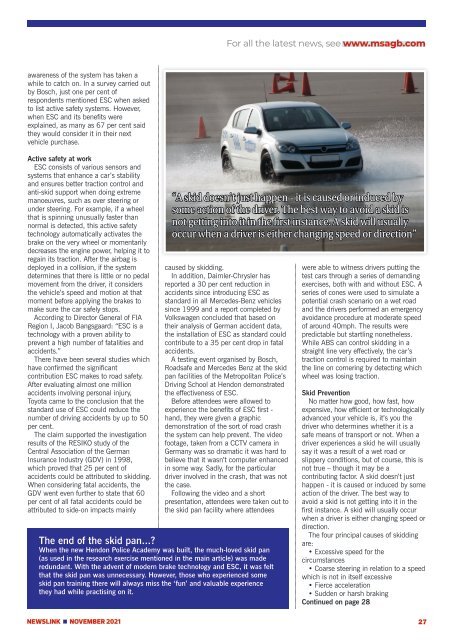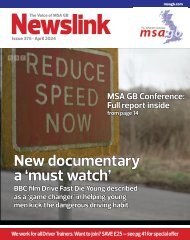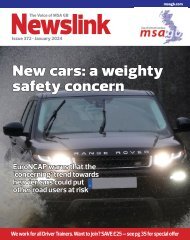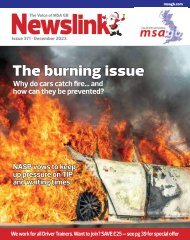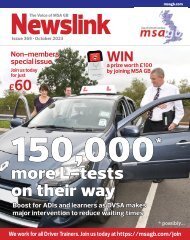MSA Newslink November 2021
Motor Schools Association, driver training and testing, road safety
Motor Schools Association, driver training and testing, road safety
You also want an ePaper? Increase the reach of your titles
YUMPU automatically turns print PDFs into web optimized ePapers that Google loves.
For all the latest news, see www.msagb.com<br />
awareness of the system has taken a<br />
while to catch on. In a survey carried out<br />
by Bosch, just one per cent of<br />
respondents mentioned ESC when asked<br />
to list active safety systems. However,<br />
when ESC and its benefits were<br />
explained, as many as 67 per cent said<br />
they would consider it in their next<br />
vehicle purchase.<br />
Active safety at work<br />
ESC consists of various sensors and<br />
systems that enhance a car’s stability<br />
and ensures better traction control and<br />
anti-skid support when doing extreme<br />
manoeuvres, such as over steering or<br />
under steering. For example, if a wheel<br />
that is spinning unusually faster than<br />
normal is detected, this active safety<br />
technology automatically activates the<br />
brake on the very wheel or momentarily<br />
decreases the engine power, helping it to<br />
regain its traction. After the airbag is<br />
deployed in a collision, if the system<br />
determines that there is little or no pedal<br />
movement from the driver, it considers<br />
the vehicle’s speed and motion at that<br />
moment before applying the brakes to<br />
make sure the car safely stops.<br />
According to Director General of FIA<br />
Region I, Jacob Bangsgaard: “ESC is a<br />
technology with a proven ability to<br />
prevent a high number of fatalities and<br />
accidents.”<br />
There have been several studies which<br />
have confirmed the significant<br />
contribution ESC makes to road safety.<br />
After evaluating almost one million<br />
accidents involving personal injury,<br />
Toyota came to the conclusion that the<br />
standard use of ESC could reduce the<br />
number of driving accidents by up to 50<br />
per cent.<br />
The claim supported the investigation<br />
results of the RESIKO study of the<br />
Central Association of the German<br />
Insurance Industry (GDV) in 1998,<br />
which proved that 25 per cent of<br />
accidents could be attributed to skidding.<br />
When considering fatal accidents, the<br />
GDV went even further to state that 60<br />
per cent of all fatal accidents could be<br />
attributed to side-on impacts mainly<br />
“A skid doesn’t just happen - it is caused or induced by<br />
some action of the driver. The best way to avoid a skid is<br />
not getting into it in the first instance. A skid will usually<br />
occur when a driver is either changing speed or direction”<br />
caused by skidding.<br />
In addition, Daimler-Chrysler has<br />
reported a 30 per cent reduction in<br />
accidents since introducing ESC as<br />
standard in all Mercedes-Benz vehicles<br />
since 1999 and a report completed by<br />
Volkswagen concluded that based on<br />
their analysis of German accident data,<br />
the installation of ESC as standard could<br />
contribute to a 35 per cent drop in fatal<br />
accidents.<br />
A testing event organised by Bosch,<br />
Roadsafe and Mercedes Benz at the skid<br />
pan facilities of the Metropolitan Police’s<br />
Driving School at Hendon demonstrated<br />
the effectiveness of ESC.<br />
Before attendees were allowed to<br />
experience the benefits of ESC first -<br />
hand, they were given a graphic<br />
demonstration of the sort of road crash<br />
the system can help prevent. The video<br />
footage, taken from a CCTV camera in<br />
Germany was so dramatic it was hard to<br />
believe that it wasn’t computer enhanced<br />
in some way. Sadly, for the particular<br />
driver involved in the crash, that was not<br />
the case.<br />
Following the video and a short<br />
presentation, attendees were taken out to<br />
the skid pan facility where attendees<br />
The end of the skid pan...?<br />
When the new Hendon Police Academy was built, the much-loved skid pan<br />
(as used in the research exercise mentioned in the main article) was made<br />
redundant. With the advent of modern brake technology and ESC, it was felt<br />
that the skid pan was unnecessary. However, those who experienced some<br />
skid pan training there will always miss the ‘fun’ and valuable experience<br />
they had while practising on it.<br />
were able to witness drivers putting the<br />
test cars through a series of demanding<br />
exercises, both with and without ESC. A<br />
series of cones were used to simulate a<br />
potential crash scenario on a wet road<br />
and the drivers performed an emergency<br />
avoidance procedure at moderate speed<br />
of around 40mph. The results were<br />
predictable but startling nonetheless.<br />
While ABS can control skidding in a<br />
straight line very effectively, the car’s<br />
traction control is required to maintain<br />
the line on cornering by detecting which<br />
wheel was losing traction.<br />
Skid Prevention<br />
No matter how good, how fast, how<br />
expensive, how efficient or technologically<br />
advanced your vehicle is, it’s you the<br />
driver who determines whether it is a<br />
safe means of transport or not. When a<br />
driver experiences a skid he will usually<br />
say it was a result of a wet road or<br />
slippery conditions, but of course, this is<br />
not true – though it may be a<br />
contributing factor. A skid doesn’t just<br />
happen - it is caused or induced by some<br />
action of the driver. The best way to<br />
avoid a skid is not getting into it in the<br />
first instance. A skid will usually occur<br />
when a driver is either changing speed or<br />
direction.<br />
The four principal causes of skidding<br />
are:<br />
• Excessive speed for the<br />
circumstances<br />
• Coarse steering in relation to a speed<br />
which is not in itself excessive<br />
• Fierce acceleration<br />
• Sudden or harsh braking<br />
Continued on page 28<br />
NEWSLINK n NOVEMBER <strong>2021</strong><br />
27


